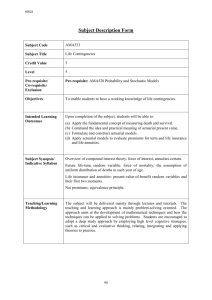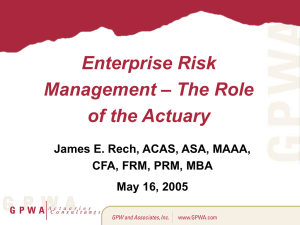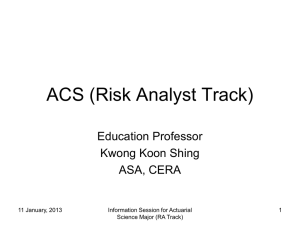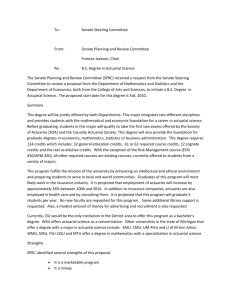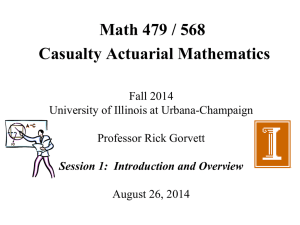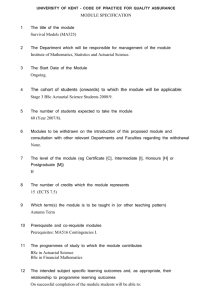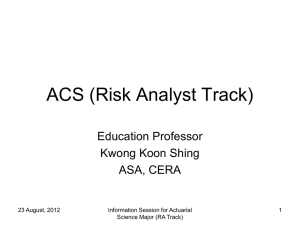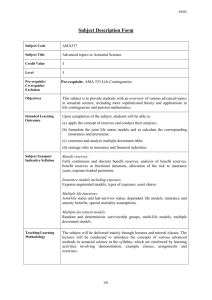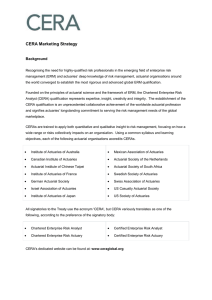here
advertisement
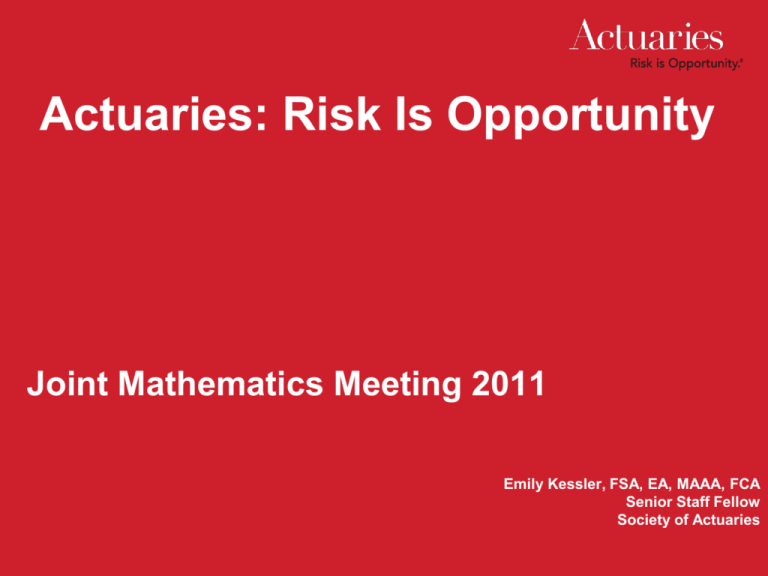
Actuaries: Risk Is Opportunity Joint Mathematics Meeting 2011 Emily Kessler, FSA, EA, MAAA, FCA Senior Staff Fellow Society of Actuaries Actuaries… Analyze, measure, convert and manage risk into opportunity Use mathematical and statistical analytical skills, financial theory, business knowledge and an understanding of human behavior Develop and validate financial models to guide decision making Are creative problem solvers who see the “whole picture” 2 2 Rigorous framework Actuarial science is interdisciplinary Center: risk Methodology: math models within specific context Rigorous analysis Practical over theoretical 3 3 Shifting focus of actuarial science All about risk • Old school: Possibility of loss • New school: Risk/reward trade offs All about managing risk: to avoid, reduce, transfer or manage (exploit) an enterprise’s risk • Old school: segregated within specific mechanisms (insurance, pensions) • New school: any enterprise, anywhere, with the right financial vehicle (moving beyond insurance) 4 Opportunities For Actuaries 5 Traditional Opportunities Health Insurance Life Insurance Property/Casualty Insurance Pension/Retirement 6 6 New opportunities: Enterprise Risk Management (ERM) Growing need for organizations to link their risks across their business units and adopt a more comprehensive framework ERM is the process of risk analysis and management across an entire organization Mostly used (especially by actuaries) in insurance, financial sector • Moving into broader business 7 7 Why become an actuary? Combines passion for math with business • Wide variety of opportunities, careers and growth U.S. Department of Labor • Actuarial employment expected to increase by 24% through 2016 • Less sensitive to economic cycles Financial rewards • Entry level salaries of $46,000-65,000 Education benefits • Learn while you earn – Most employers provide full educational financial support while you pursue your credentials 8 Earning Potential: Average Salaries Years of Experience Note: Compensation may vary significantly according to specialty, years of experience, geographic region and responsibilities. Source: D.W. Simpson & Company, Inc., October 2009 Salary Survey. Visit: www.DWSimpson.com/Salary for more information. 9 9 A Strong Career Outlook The profession is becoming more relevant to the needs of larger companies Actuarial jobs remain steady High value of enterprise risk management (ERM) Role of Chief Risk Officer (CRO) opening up to actuaries 10 What Employers Value CRITICAL ACTUARIAL BUSINESS CREDENTIALS SKILLS 11 11 Academic Studies Actuaries come from a range of disciplines including actuarial science, math, finance, statistics and engineering Students should complete courses in probability, calculus and business communications Other foundational coursework includes economics, applied statistics and corporate finance 12 12 Advice for Actuarial Students Develop disciplined study habits Acquire a well-rounded curriculum • Sharpen communication and business skills Take SOA/CAS actuarial exams while in school Obtain an actuarial internship Find mentors 13 Becoming an Actuary 14 Credentials for practice Life/Health/Pension (Society of Actuaries) • Associate of the Society of Actuaries (ASA) • Fellow of the Society of Actuaries (FSA) • Chartered Enterprise Risk Analyst (CERA) Property/Casualty (Casualty Actuarial Society) • Associate of the Casualty Actuarial Society (ACAS) • Fellow of the Casualty Actuarial Society (FCAS) • Coming soon: CERA 15 The Society of Actuaries (SOA) Serves actuaries in pension, life and health • Largest professional, actuarial organization in the world 22,000 members, 30,000 candidates Mission: actuaries as leading professionals in the measurement and management of risk • Education • Research • Advancing the profession 16 16 The Casualty Actuarial Society (CAS) Serves actuaries in property & casualty disciplines Over 5,100 members Mission: Advancement of the body of knowledge of actuarial science applied to property, casualty, and similar risk exposures. • Communicating with the public • Education • Research 17 ERM Professional Credential: Chartered Enterprise Risk Analyst (CERA) Developed in response to nontraditional business needs CERAs model future events by converting data that drives strategic decisions with a 360degree view of an organization’s risk profile To learn more about the CERA credential, visit www.CERAnalyst.org 18 18 Benefits of a CERA Designation The most comprehensive and rigorous ERM training available Enhance exposure to the C-suite Expands professional network by being a member of the SOA Now a globally offered and recognized credential – offered by the UK Actuarial Profession and the Institute of Actuaries of Australia Others soon to follow 19 ASA Designation 20 ACAS Designation Exam 1/P* Exam 5 Exam 2/FM* Exam 6 Exam 3F/MFE* Online Course 1 Exam 3L Online Course 2 CAS Course on Professionalism Exam 4/C* VEE* (Economics, Corporate Finance, Applied Statistics) *Shared with SOA 21 FSA Designation 22 FCAS Designation Exam 7 ACAS + Exam 8 Exam 9 23 CERA Credential (SOA) 24 24 CERA & FSA (SOA) 25 Resources for students RiskIsOpportunity.net BeAnActuary.org ImageoftheActuary.org SOA.org CASACT.org 26 Questions? 27 Thank You! SOA.org RiskIsOpportunity.net

